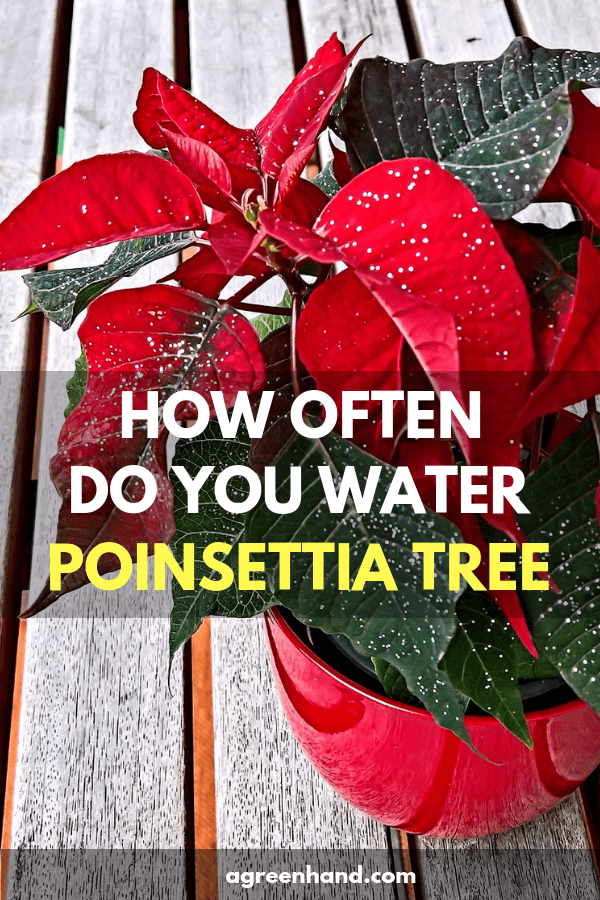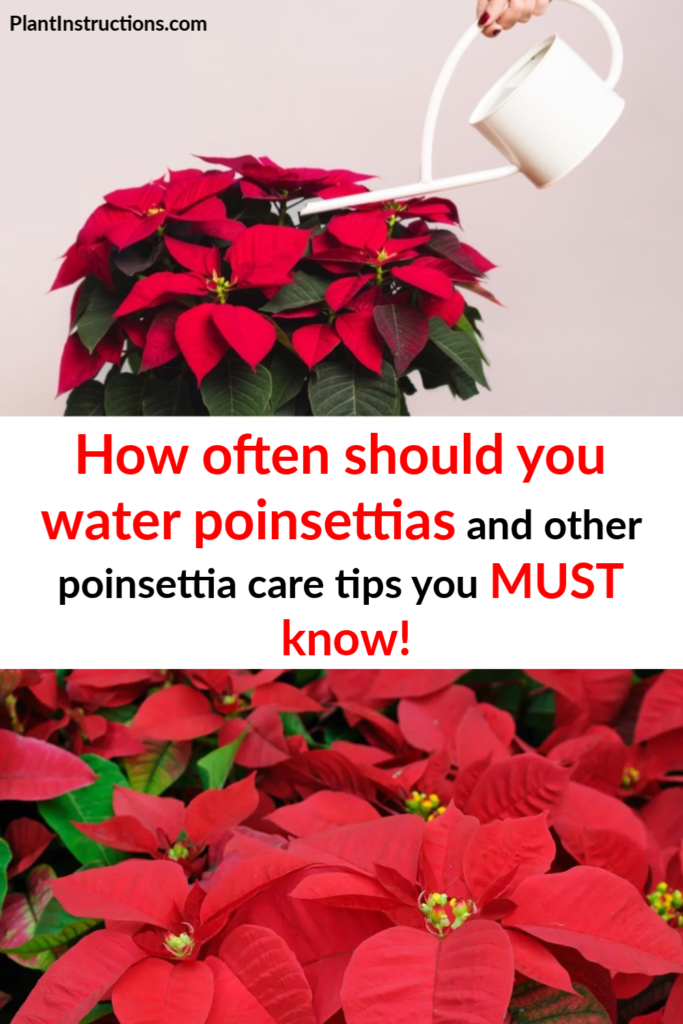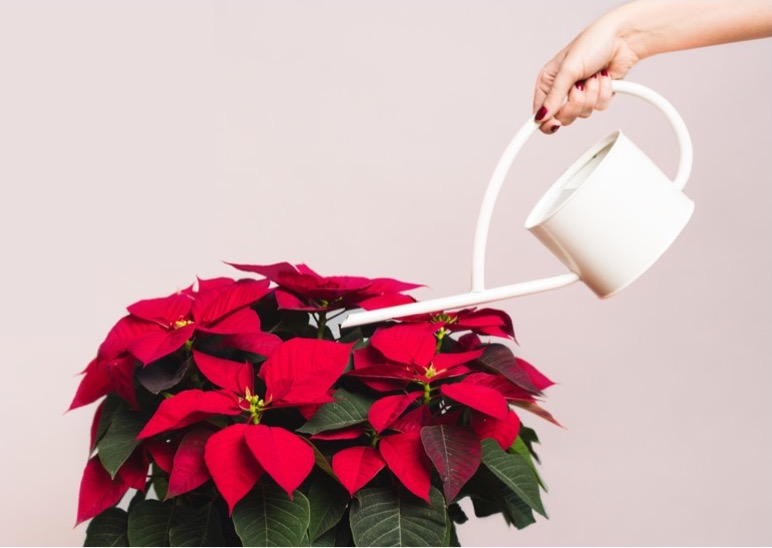Between waterings, the top inch of the soil must dry out for poinsettias. Give poinsettias a good bath so that water comes out of the pots’ drainage holes. Typically, watering poinsettias once a week with a deep soak satisfies the plant’s hydration needs without leading to root rot.
Knowing when and how much to water poinsettias is crucial since they are sensitive to both overwatering and underwatering.
To determine the best watering frequency for your climate and the circumstances in your home, keep reading.
Table of Contents
How Often to Water Poinsettias
Poinsettia shrubs are indigenous to Mexico and Central America, where they thrive in humid, warm, tropical climates with sporadic rainfall.
Poinsettia are well suited to the circumstances of their natural habitat, which translates well to thriving as house plants. However, they are sensitive to both overwatering and underwatering and like the soil to somewhat dry out between waterings rather than consistently moist or damp soil.
Poinsettias should be grown indoors under conditions that closely resemble their natural habitat, including soil moisture cycles and irrigation schedules.
Poinsettias demand a thorough soaking followed by a brief period of soil evaporation in between waterings. To maintain health and prevent root rot, poinsettias often need to be watered once per week.
When determining how frequently to water poinsettias, there are a number of variables to consider because the rate at which the soil dries out might alter depending on things like…
- The environment’s normal humidity level (humidity reduces water loss from the leaves and slow evaporation from the soil which can mean you water the poinsettia less often).
- How big is your pot? (smaller pots dry out much quicker).
- Whether the poinsettia is exposed to air conditioning currents, forced air, or any drafts (air currents can sap moisture from the leaves and increase the poinsettias demand for water).
- the soil’s ability to hold onto moisture.
To determine how frequently to water your poinsettia at home, feel the soil to check for wetness.
If the soil is wet, wait a day or two before watering; however, if the soil feels dry to the touch at a depth of one inch, now is the ideal time to water.
This watering cycle provides poinsettias with the ideal moisture balance for a healthy plant and to prevent the effects of under- and overwatering.
Additionally, it imitates the natural environment’s watering cycle.
It should be noted that misting your plant’s leaves with water once or twice a week can help it mimic the more humid conditions seen in its native habitat.
Poinsettias should receive continuous watering all year long, but keep in mind that demand may change if, for instance, the heating is used more frequently in the winter, which can rapidly cause the pot to dry out.
To prevent root rot and keep a healthy plant, you should always wait until the top inch of the soil has dried out between waterings, although you can adjust your watering frequency during the year if necessary.
How to determine whether your poinsettias need more or less water…
It might be challenging to distinguish between an overwatered and underwatered plant based just on appearance because the leaves of your poinsettia will turn yellow and begin to droop if it is either over or under watered.
In contrast to plants that are overwatered, poinsettias under drought stress have somewhat more shriveled, wilted, or curled leaves that can drop off in response to drought.
By feeling the soil, you may quickly determine what is causing the leaves to become yellow. Give your poinsettia a good soak if the soil is completely dried out.
In order for the water to properly permeate the soil and provide the roots with the much-needed water, it is ideal to submerge the plant pot in a basin of water for around 10 minutes.
Reduce the watering so that the top inch of soil dries out if your poinsettia appears to have been overwatered and the soil is excessively wet.
Due to the increased risk of root rot, which causes poinsettias to die back, overwatered plants are more challenging to revive than underwatered ones.
To learn how to save a dying poinsettia plant, read my post.
How Much to Water Poinsettias
How frequently to water poinsettias can vary depending on the environment and the circumstances within the house, but the volume of water should remain constant.
Give poinsettias a generous soak, letting any extra water drip out the bottom of the pot.
By doing this, you may be sure that the water has permeated the soil sufficiently so that the poinsettia’s roots can absorb the water they need.
For a robust, more durable poinsettia, a good soak also stimulates the roots to grow and establish in the soil.
When plants are watered too sparingly, the top inch or so of soil is only slightly moistened, and the water does not reach the plant’s roots where it is needed, which might even cause drought stress.
In order to replicate the cycle of rainfall, followed by a time of dryer weather, in the poinsettia’s native habitat, water the soil thoroughly, then let it dry.
Water Poinsettias in pots with Drainage Holes in their Base
The easiest approach to make sure you have given your poinsettia adequate water is to water until water begins to emerge from the pot’s base.
If your poinsettia is in a pot without drainage holes, water will collect around the roots and cause root rot, which will cause the poinsettia to die.
If there is still too much water in the area around the roots, the soil will remain soggy.
- Underneath the pots are trays and saucers. After a round of watering, people frequently use saucers or trays to stop water from pouring inside their house. It is imperative that you constantly dump the container because if there is any standing water, the soil won’t dry out enough for the poinsettia and the plant will wither.
- In the drainage holes, there are roots and compacted earth. Check to see sure the drainage holes are clear if you find that your poinsettia is losing water slowly in order to avoid root rot.
- outside pots that add style. Poinsettias are frequently offered for sale in plastic pots with drainage holes, but during the holiday season, they are also offered in attractive outer pots. Use a saucer or tray to plant poinsettias in a pot with drainage holes if the outer pot is preventing water from exiting properly and keeping the soil moist, which can lead to root rot.
Key Takeaways:
- To meet the watering needs and prevent root rot, water poinsettias only after the top inch of soil has dried out. Give poinsettias a generous soak to the point where water drips from the pot’s bottom.
- Watering should be done once a week, on average. Adapt the watering schedule to your conditions.
- To let excess water to drain and prevent root rot, poinsettias should be planted in containers with drainage holes in the bottom.
- The leaves of a poinsettia will turn yellow and droop if it is overwatered or underwatered. Poinsettias with inadequate watering also lose leaves.
FAQ
Will an overwatered poinsettia recover?
Check for root rot, cut off any rotting roots, repot the plant, and change your watering schedule if you overwatered the plant. When the top inch of soil seems dry to the touch, water your poinsettia only then. Wait one or two days before checking the soil again if it’s still a little moist.
What does an over watered poinsettia look like?
Lower leaves will drop and turn yellow if they are overwatered. A plant’s root rot and eventual death might result from over watering. Dry plants wilt and prematurely lose their leaves.
Can you overwater a poinsettia?
For poinsettias, both overwatering and underwatering are problematic. Lower leaves will drop and turn yellow if they are overwatered. A plant’s root rot and eventual death might result from over watering.
What happens if you water a poinsettia too much?
Any extra water that accumulates in the saucer or the attractive foil pot cover should be discarded. Poinsettias will experience root rot and eventually die if let to stand in too much water.
Do poinsettias like lots of water?
Poinsettias don’t like to be constantly wet, so just water them when they need it (when the soil feels light or when it feels dry to the touch). Start fertilizing the poinsettia with a quality, balanced fertilizer around the first of March. It works nicely to use a water-soluble fertilizer like Miracle-Grow or Peter’s.



